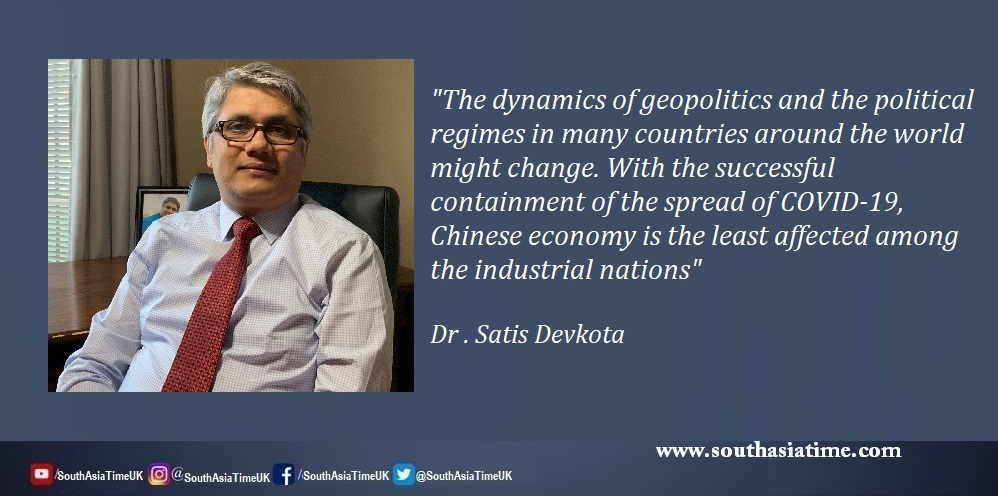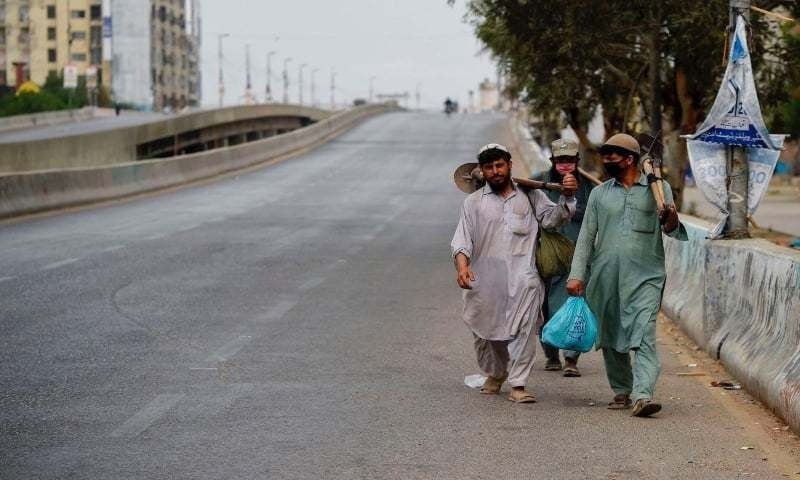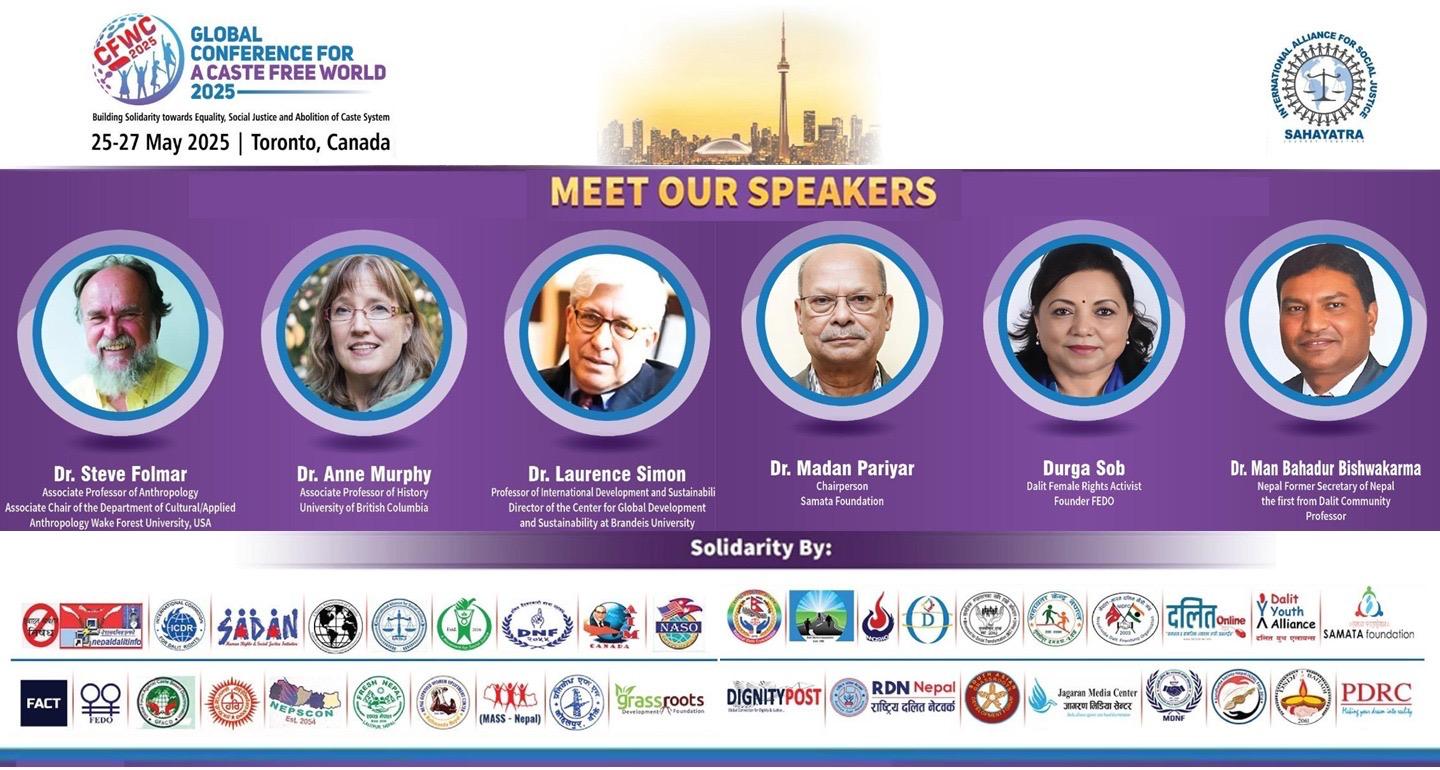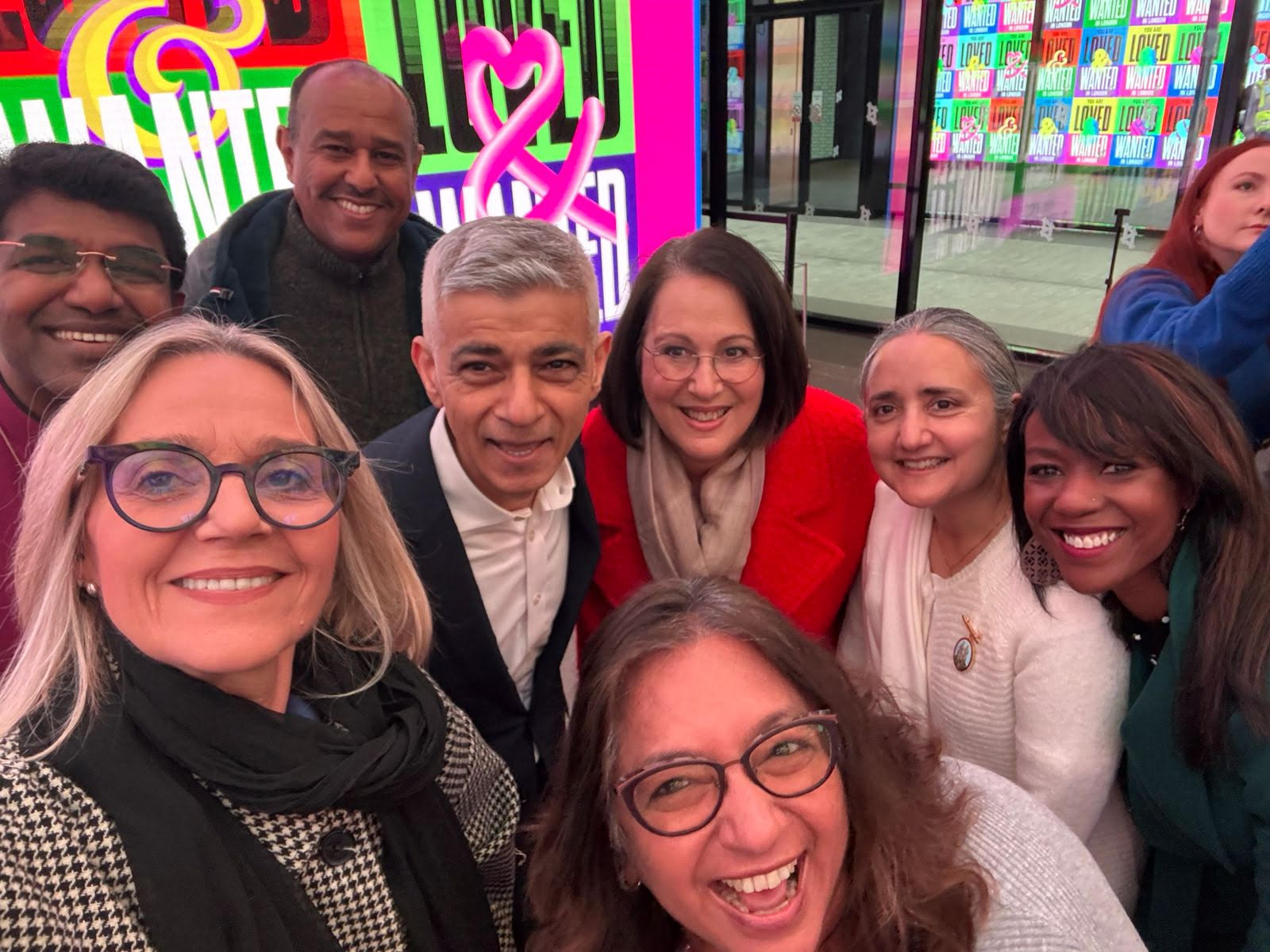‘Cash transfers help the poor and marginalised population from shocks of pandemic’

 After obtaining Masters in Economics from the Tribhuvan University, Kathmandu, SATIS DEVKOTA worked with the Nepal Electricity Authority (NEA) and also taught at a Campus affiliated to the KathmanduUniversity. He later pursued his Ph. D. from the Wayne State Univeristy of the US. He is currently working as Assistant Professor of Economics and Management at the University of Minnesota-Morris. His research papers have been published in a number of journals. DR DEVKOTA spoke with BHAGIRATH YOGI and JAGAN KARKI on the impact of Covid-19 on South Asian economies. Excerpts of the interview:
After obtaining Masters in Economics from the Tribhuvan University, Kathmandu, SATIS DEVKOTA worked with the Nepal Electricity Authority (NEA) and also taught at a Campus affiliated to the KathmanduUniversity. He later pursued his Ph. D. from the Wayne State Univeristy of the US. He is currently working as Assistant Professor of Economics and Management at the University of Minnesota-Morris. His research papers have been published in a number of journals. DR DEVKOTA spoke with BHAGIRATH YOGI and JAGAN KARKI on the impact of Covid-19 on South Asian economies. Excerpts of the interview:
How do you see the response of South Asian governments to fight the Covid 19?
The COVID-19 outbreak was initiated from Wuhan, China, in December 2019 and it was announced as a pandemic on March 11, 2020 by the World Health Organization (WHO). In South Asia, Nepal reported the first confirmed case of COVID-19 on January 24, 2020. As of May 17, 2020, India has confirmed 95,664 cases and 3,025 deaths followed by Pakistan, which has recorded 40,151 cases and 873 deaths. Similarly, Bangladesh has confirmed 22,268 cases and 328 deaths while Afghanistan has confirmed 6,664 cases and 169 deaths. Besides, Maldives has confirmed 1,090 cases and 4 deaths, Sri Lanka has confirmed 981 cases and 9 deaths, Nepal has confirmed 295 cases and 2 deaths, and Bhutan has reported 21 cases and 0 deaths. In total, South Asia has reported 167,134 cases and 4,410 deaths.
The area of the South Asian region is one half of the size of the United States and its population is five times higher. There are uncomparable differences in the health care system, quality of the health care services, and the health insurance coverage between the US and the South Asian countries. That difference is also reflected in their per capita gross domestic products and the availability of resources for investment in the healthcare system in South Asia. The total number of physicians, nurses, hospital beds, ventilators and ICU beds per 1,000 population available in South Asia is much lower than those in the United States. However, the story of COVID-19 is reversed. As of May 17, 2020, the total number of confirmed cases in the United States is 8.87 times higher(1,482,916) and the total number of deaths is 20.26 times higher (89,372) than in South Asia.
Due to the lack of sufficient testing kits and limited availability of budget, the tracing, testing, and treating strategy was not implemented in a very organized way in South Asia. The response on lockdown and social distancing was implemented from the very beginning and people also contributed voluntarily with certain exceptions to the governments’ efforts in lockdown and social distancing. At the community level, enforcing lockdown and social distancing was a little problem during the time of Ramadan among the Muslim communities in Afghanistan, Pakistan, India, Bangladesh, and in the certain localaties in Nepal too. After Ramadan, the lockdown was strictly continued again. That helped to keep the infected individuals in isolation, reduce the infection rates (R0 value) and flatten the curves of the total number of confirmed cases, hospitalizations, and deaths in South Asia. However, the danger of increasing the infection rate (R0) is not over yet. Challenges such as limitations of healthcare facilities, lack of medical supplies to fight the virus, existence of chronic poverty and hunger, issues of the urban slums, and lack of proper cleanliness at home, in the hospitals, and at the workplaces are teasing the South Asian policy makers.
Countries like India and Pakistan have introduced cash transfer programmes to support poor and marginalised communities. How effective are these programmes?
Because of the global economic fallout triggered by the COVID-19 pandemic, the South Asian economy is forecasted to shrink. The estimated growth rate for the region will fall to a range between 1.8 to 2.8 percent in 2020, which is down by 4.5 to 3.5 percent from the previous projection made six months before. That could create multiple effects in society. It increases unemployment, reduces average income of households, and enhances poverty, hunger, and malnutrition. That all collectively affects aggregate demand and destabilizes the global supply chain. In that case, recovery is costly and a lengthy process. That will have severe implications to the poor and marginalised population in society for the longer period of time.
It will also enhance inequalities, social crimes, prostitutions, insecurity, vulnerability, and marginalisation. That may inflict the public health emergency from other aspects as well. Lockdown, social distancing, and isolation measures will not be effective if the problems of the poor and marginalized are not addressed timely. If the poorest and most marginalized within a society are not protected then no one is safe. Realizing this fact, India and Pakistan have announced an economic relief package (cash transfer program) in the recent past. That will help smooth consumption, and expand the ability of poor and vulnerable to utilize health care facilities at their difficulties.
Cash transfers also help to prevent the poor and marginalised population in suffering from shocks of pandemic. This helps to reduce inequality and other problems stated above and restores the demand side of the economy. Besides, it helps to enhance the individual’s motivation to follow the rules of lockdown, social distancing, and isolation, and ultimately helps to flatten the curve. Hope, other South Asian governments will learn lessons from India and Pakistan and announce similar economic resque packages as soon as possible or be ready to face the steep challenges for recovery.
If the South Asian governments have a better database of poor and marginalized people and if the cash transfer is fairly distributed to each household based on their level of income, that intervention must be effective to address the above stated issues and to keep the demand side of the economy intact. In addition, that encourages the poor and marginalized to stay inside their house which is the key to control the transmission rate at its low in the region. Unlike the system in the United States and other developed countries, almost every country in South Asia does not have a good database. Governments cannot transfer the cash directly to their bank accounts or send the cheque to each household below the poverty line. This is the biggest challenge to avoid corruption in the process of distributing the transfer cash to the poor and the vulnerable. This issue must be carefully addressed.

File photo / AFP
Many believe that the Covid-19 exposed the faultlines in our society, especially the plight of women, poor and migrant workers. How do you think they can be protected?
If they are not protected in the real sense and discriminated by gender, caste and ethnicity, country of origin, and their income level, sooner or later they might be translated into the pandemic bomb that can burst any time in the society. We know, viruses do not have boundaries, it can affect people of any class, wealth, ethnicity, or status and public health is determined by the least common denominator. I hope South Asian policy makers understand these facts. Thus, the poor and vulnerable must get unconditional cash from the government, and free testing, tracing, and treating facilities. That will save the lives of thousands of other people in the whole region. However, we have heard the heart touching stories of migrant workers in the Gulf countries and Nepali migrant workers in India too! The government-to-government level talks must resolve this humanitarian issue. The host country must allow the immigrant workers to stay and treat them equally as their citizens at this difficult time. They must understand that the immigrant workers are the pillars of their robust economy.
Many South Asian countries depend on remittance but millions of South Asian migrant workers are likely to lose their jobs due to the Covid-19 crisis. What should the South Asian governments do to help these people resettle and find jobs within their own countries?
The South Asian governments have to design the short-term, medium-term, and long-term policies to address the escalating unemployment caused by COVID-19. Look at the current unemployment crisis in the US and the developed countries. It is skyrocketing. This is what happened during the short-run. This issue has been addressed by providing unconditional cash transfer as an unemployment benefit in the US. This is what the South Asian governments want to do in the short-run. In the medium-term, the governments can design innovative policies to enhance agricultural productivity and create thousands of new employment opportunities in rural agriculture. That can be done by implementing enterprise farming or leasehold farming techniques. In developing South Asia, every dollar increase in GDP has a much larger effect in rural employment creation and poverty alleviation than the same dollar amount increase in the industrial sector until the region moves to the middle-income status. In the long-run, the increased productivity in agriculture might have multiplier effect on other sectors of the economy. For Asia, that value of multiplier is between 1.6 to 1.8. This means that every one dollar growth in agriculture induces another 60 to 80 cents growth in non-agriculture. That growth in non-agriculture will also create additional employment opportunities within their own countries in South Asia. I believe that strategy could help to create millions of employment opportunities in that region.
Mechanisms like South Asian Association for Regional Cooperation (SAARC) and South Asia Free Trade Area (SAFTA) have failed to bring any particular benefits to millions of people in the region. What went wrong?
The complexity of the political tension, escalating mistrust between India and other neighboring states in the most recent years in the Indian peninsula, and continuous change in geopolitical landscape in South Asia are the three fundamental causes behind the failure of SAARC and SAFTA. First, the hostile relation between India and Pakistan since the time of partition in 1947 has been escalating in the most recent years and India has revoked the autonomous status of Kashmir in August, 2019. That increased mistrust between the two nations. On the matters of terrirosm and nuclear weapons, the Indo-Pak relation has been unfriendly from the very beginning of the separation of Pakistan from India. This mistrust between the two nations is one of the major causes of the downfall of SAARC and SAFTA.
Second, the Indian behavior with the other smaller nations in the region is also problematic. For instance, India imposed a two-month-long economic blockade against Nepal at the midst of suffering from the devastating earthquake in 2015 that hurt the Nepalese feelings. That step taken by Mr Modi’s government created very bad anti-Indian sentiments among the general public in Nepal. Most recently, the union defence minister of India inaugurated a link road to Kailash-Mansarovar that connects India with China. As per Nepal’s claim, that road is located in the Nepalese territory and Nepal has considered the inauguration by India as a violation of its sovereignty. That sparked protests and enhanced mistrust between the two neighbours. There are issues with Bangladesh and Sri Lanka as well. In addition, Bangladesh proposed to establish a regional cooperative and that proposal was approved by most of the small states in the region. But India and Pakistan are skeptical of the objectives and the requirements of the new organization. Pakistan again suspects on India on the assumption that India attempts to use that cooperative to organize the small states in the region against Pakistan. Likewise, India suspects on the consolidation of powers of small nations that can create a strong voice against the Indian activities in the region. Thus, that cooperative and even the SAARC and SAFTA might not be an urgent requirement for at least for India.
Third, we should note that India contends the point of non-alignment outlined in the SAARC Charter. That means, India wants to establish its leadership in the region. However, this objective has been continuously contended in the most recent years due to the growing influence of China that reportedly wants to consolidate the power of small states in the SAARC against India. That would weaken the Indian voice at the SAARC and the Indian influence in the South Asian region. That is another cause of the downfall of SAARC and SAFTA. However, the SAARC countries are united to combat the COVID-19 infection in the region. They decided to adopt international travel ban, enforced strict lockdowns, announced special economic packages, and have set up a joint fund.
How do you see the post Corona world moving ahead? Are we going to have a fair and just society?
The dynamics of geopolitics and the political regimes in many countries around the world might change. With the successful containment of the spread of COVID-19, Chinese economy is the least affected among the industrial nations. However, the American and the European economies are most affected by the pandemic. The recovery of the broken economy in the West might take time. That creates a vacuum in the global financial system. China can fill that vacuum. Developing countries that are in a disparate need of foreign direct investment (FDI) and foreign aid can attract FDI from Chinese entrepreneurs and foreign aid from the Chinese government. If the Chinese financial system earns the global trust, that may split the US role of global central bankers between the United States and China. In that case, the world order on geopolitical relations might change.
Besides, this generation must understand the importance of the balance between environment and technology adoption. Now, the global policymakers must be serious on the issues of global warming. The existing trend on foreign direct investment and the supply chain mechanism might change significantly. Every nation must learn the lesson from the scarcity of medical equipment including mouth masks, disinfecting wipes, and the personal protective equipment (PPE). That might increase the manufacturing industries in the developed world or at least diversify the manufacturing away from China. The current, the current food consumption pattern might change. Most of the non-organic food supply might be replaced by organic foods.
We should learn a lesson from the experience of COVID-19 and establish a more fair and just society than before. Pandemics might come and go, income and wealths might be redistributed time and again, still we should not stop fighting for democracy and human rights. We should try our best to reduce inequality, and abolish poverty, hunger and malnutrition from the world.
















Facebook Comments